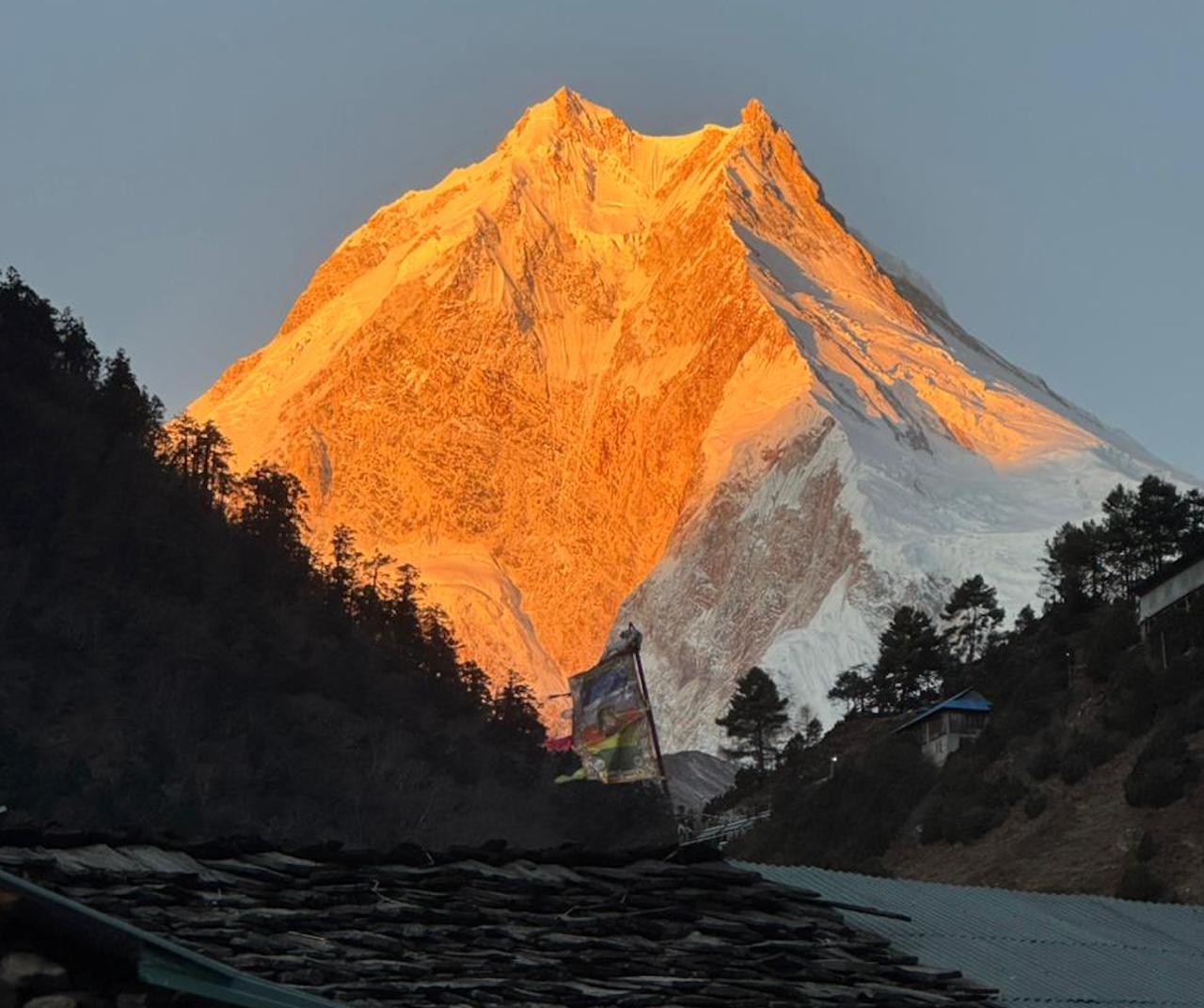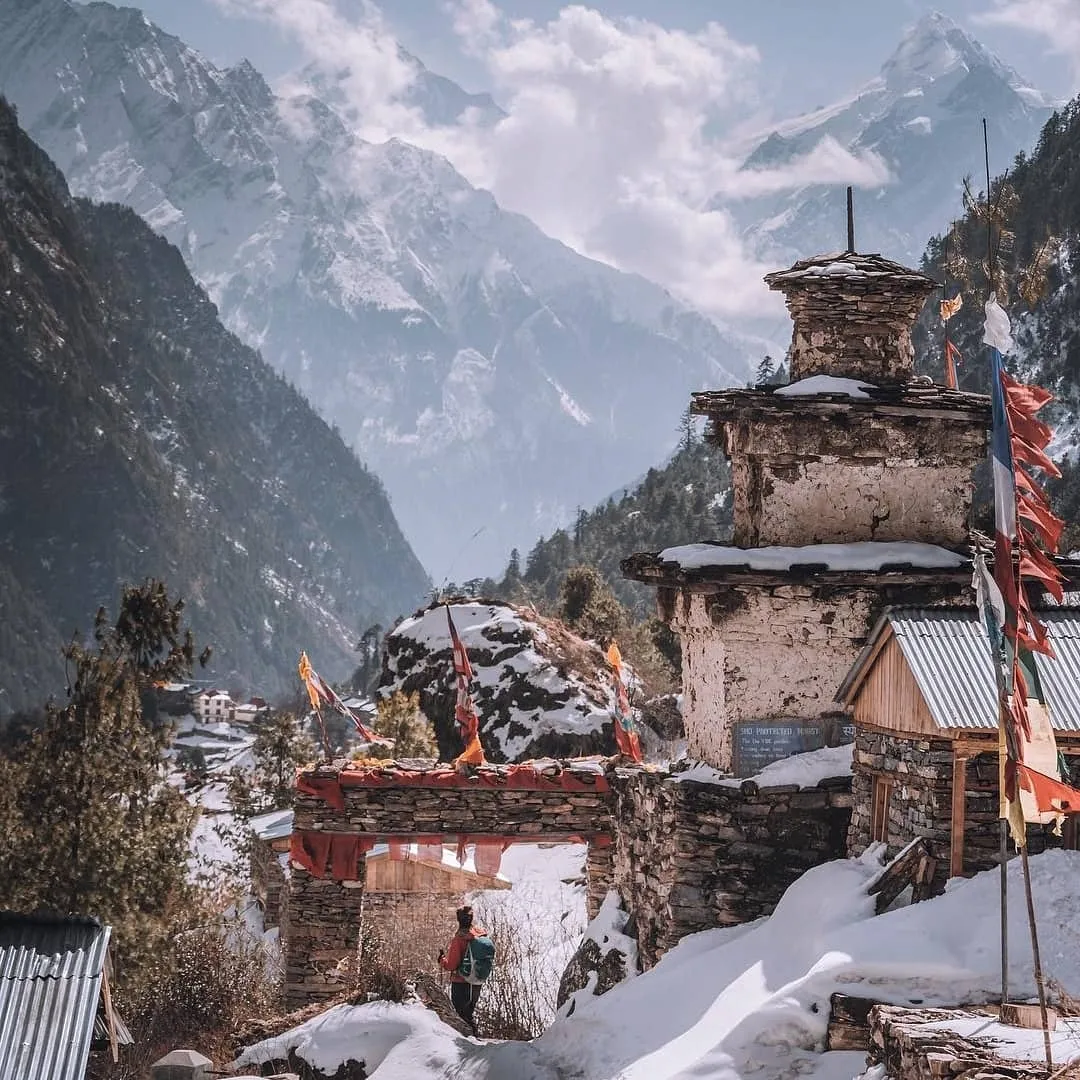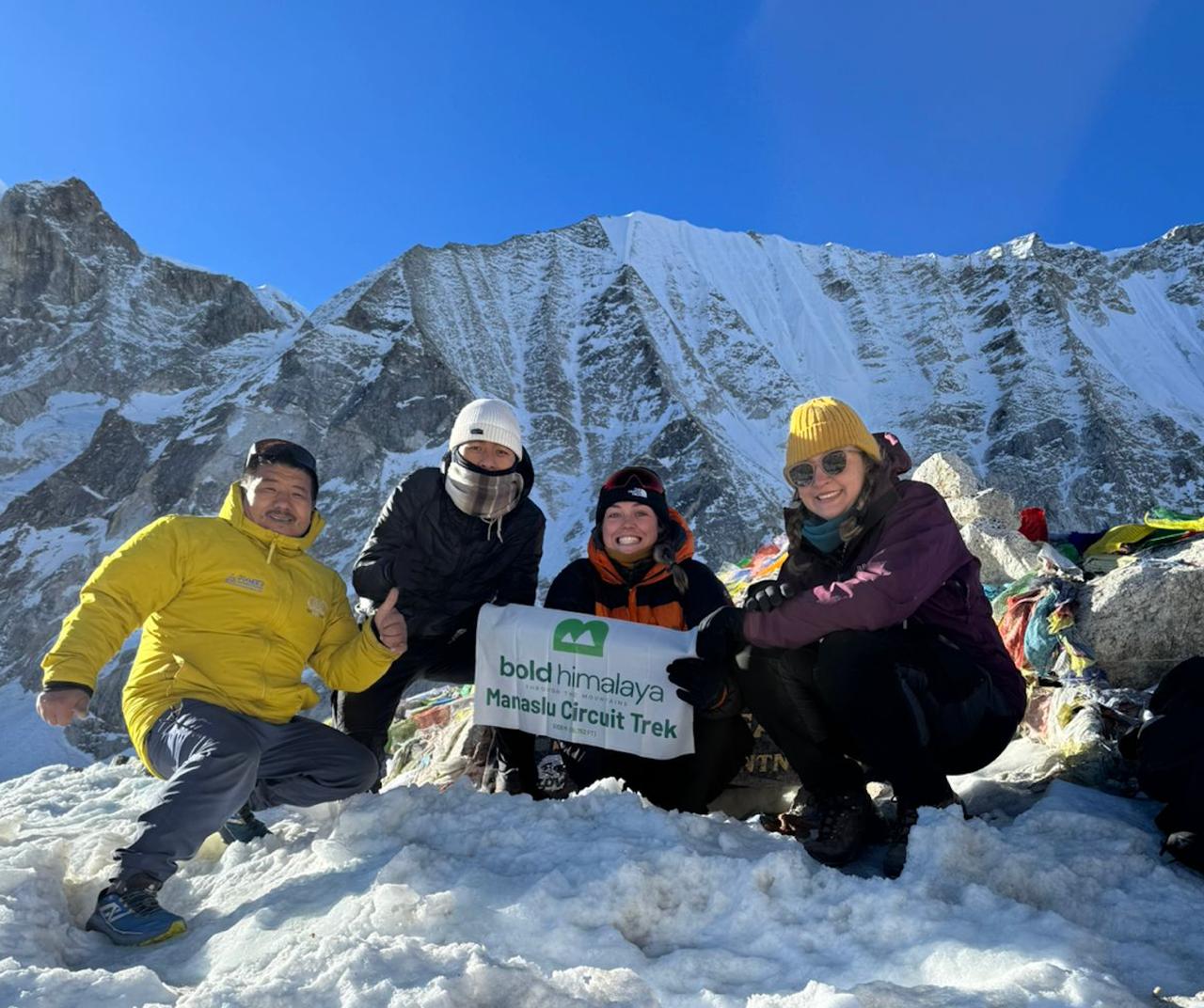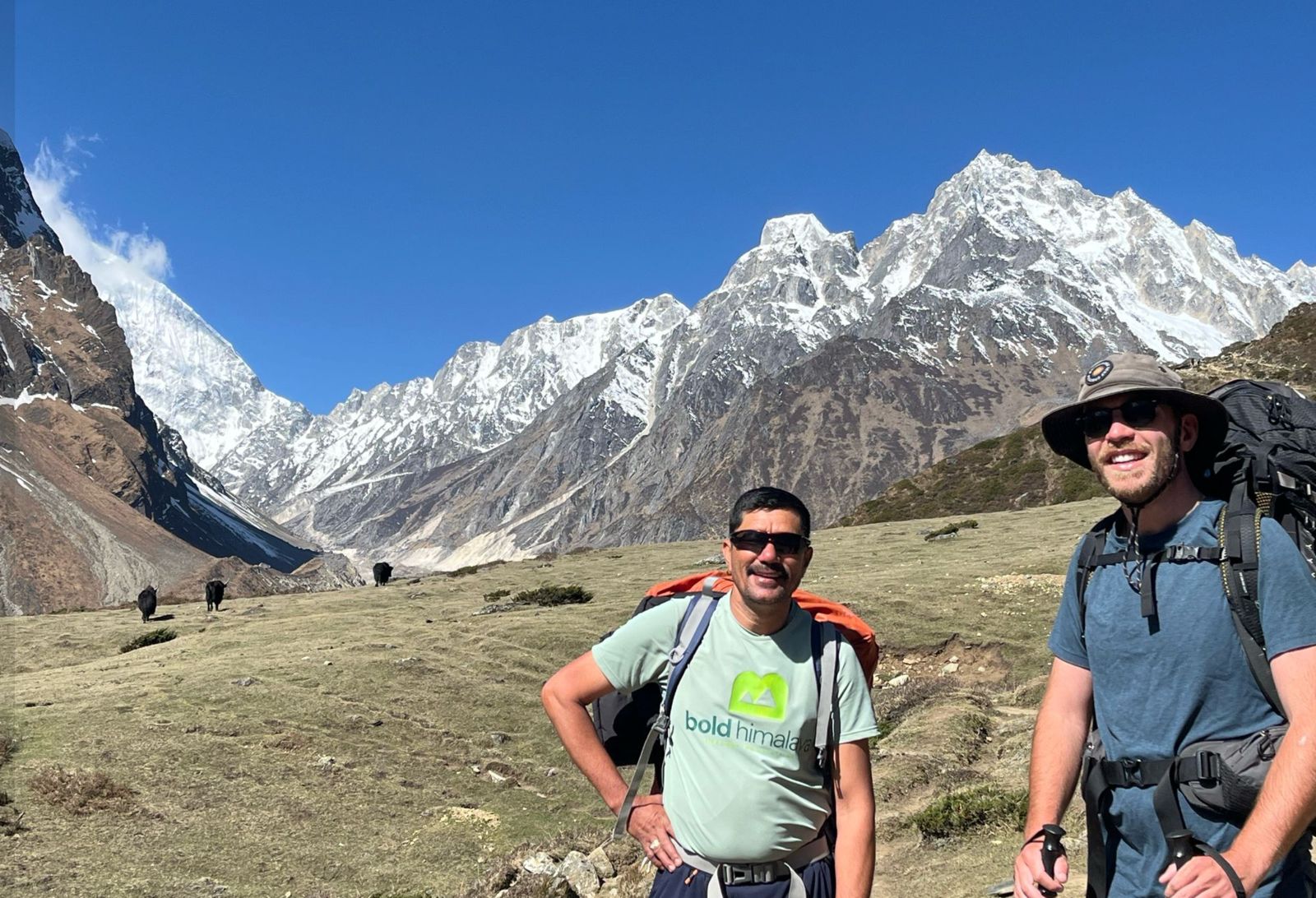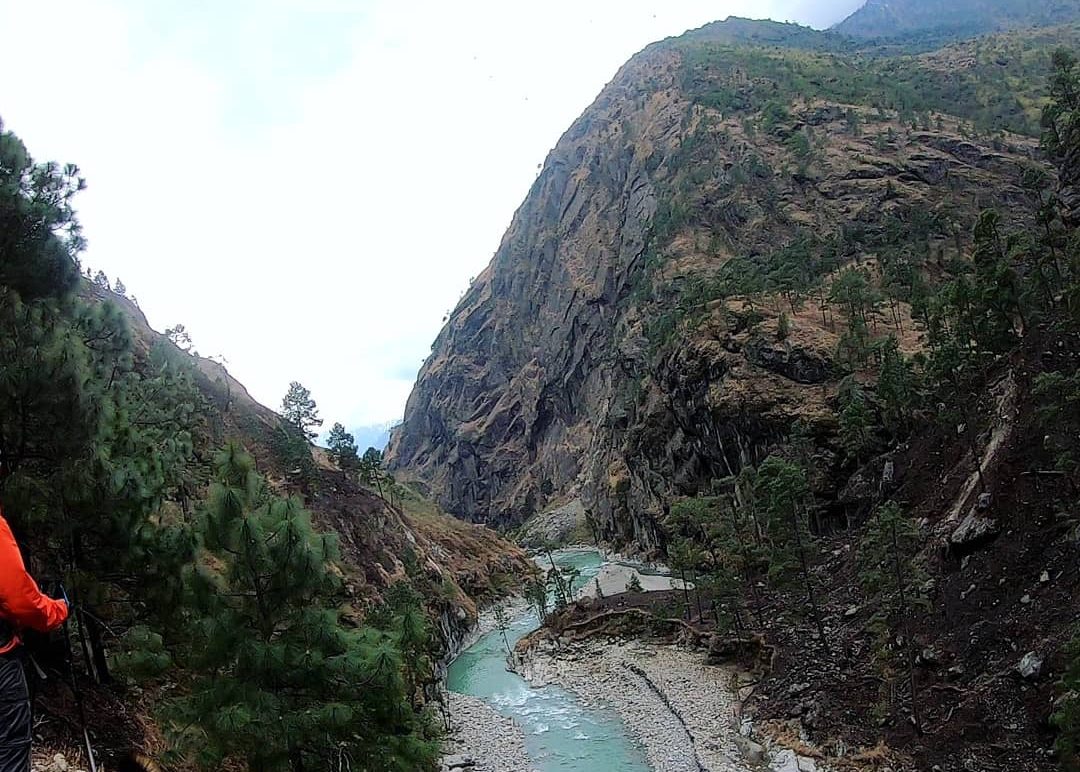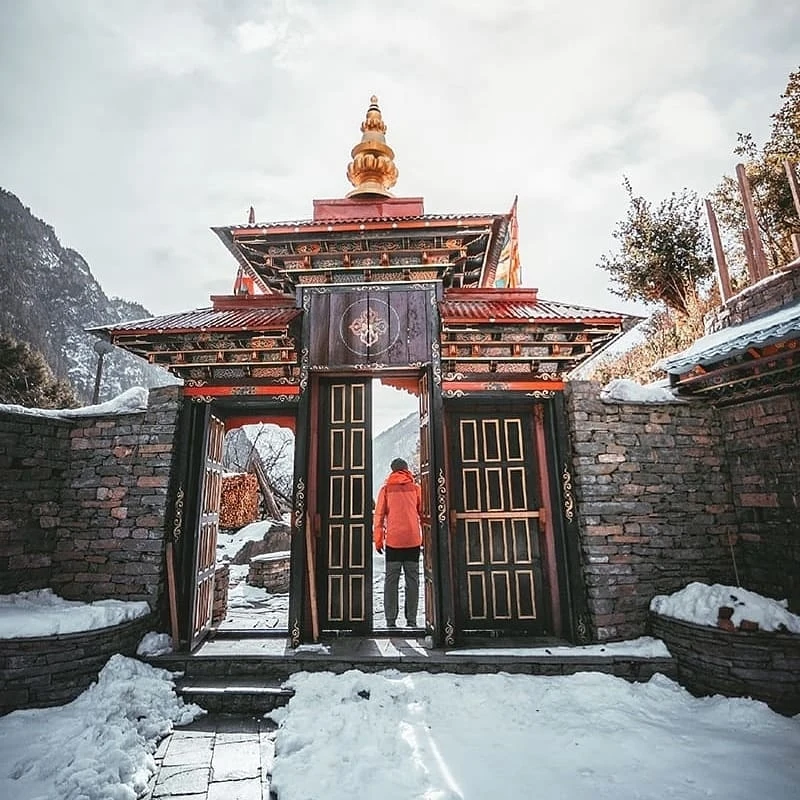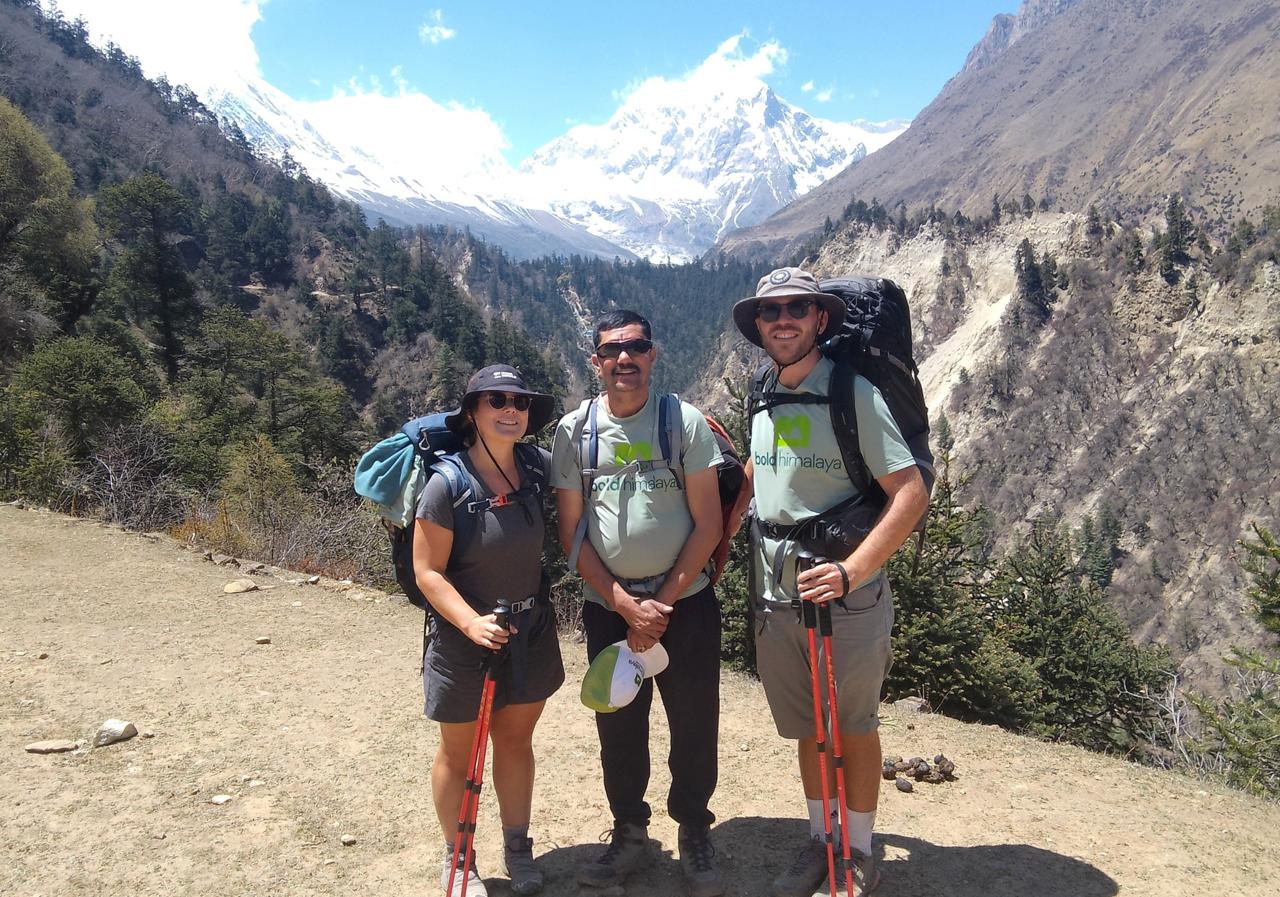Manaslu Circuit Trek
Detailed Itinerary of Manaslu Circuit Trek
Your Journey, Step by Step
Inclusions and Exclusions
What Your Adventure Covers
- Shared transportation will be provided for Maccha Khola unless private transportation is booked. You can also book private transportation for an additional cost of $200. Private transportation is suitable and affordable for a group of 4-5 and allows you to make stops on the way as you wish.
- There is a three-star hotel in Kathmandu that offers twin rooms with breakfast and a regular trekking lodge along the Manaslu Base Camp trekking trail. You can also book a hotel of your choice for an added cost.
- Full meals (breakfast, lunch, and dinner with tea or coffee) during the trek as specified in the itinerary.
- Items for first aid medications
- Permits for trekking in the Manaslu Conservation Area, Annapurna Conservation Area, restricted areas, and TIMS cards (Trekkers Information Management System)
- Knowledgeable, certified one trekking leader for groups of up to five hikers, covering their pay, lodging, lunches, and insurance
- If there are more than six hikers in the party, one support guide will cover everything, including pay, lodging, food, transportation, and insurance.
- A few essential equipment, such as a sleeping bag and a down jacket (return them after the journey)
- A goodbye program and a unique cultural performance
- T-shirt, a duffle bag for hiking, and a Trip certificate (when the trek is over)
- Our local and government taxes and formal costs
- A solo trek permit can also be made available by acquiring the permit in a group and later splitting for solo travelling.
- Additional lunch and dinner in Kathmandu,
- Dessert, and beverages of any kind while traveling
- Your travel insurance and international airline ticket
- Tips for the members of the trekking crew
Manaslu Circuit Trek Packing List
Prepare yourself for a trek of a lifetime around the Manaslu region with the right gear, outfit, and essentials. Careful packing will guarantee comfort, security, and make your trek worthwhile.
Adjustable trekking poles
Headlamp with extra batteries
Lightweight daypack (30–40L)
Duffel bag for porter load
Quick-dry trekking shirts (2 long-sleeve, 1 short-sleeve)
Waterproof and windproof jacket
Lightweight insulating down jacket
Rain jacket and rain pants
Trekking pants (2 pairs)
Convertible shorts/pants (1 pair)
Thermal base layers (2 sets)
Warm fleece jacket
Hiking socks (5–6 pairs)
Warm gloves (outer shell + inner liner)
Buff or scarf
Sun hat or cap
Woolen hat/beanie
Ear warmers
Sturdy waterproof trekking boots
Comfortable camp shoes/slippers
Gaiters (optional but useful in snow/mud)
Fleece-lined trousers (2 pairs)
Warm T-shirts (2–3)
An extra pair of thick socks for sleeping
4-season sleeping bag
Sleeping bag liner
Travel pillow (optional)
Eye mask and earplugs
Biodegradable soap and shampoo
Quick-dry towel
Wet wipes and tissues
Toothbrush and small toothpaste
Mouthwash
Lip balm with SPF
Sunscreen SPF 40+ (water-resistant)
Hand sanitizer
Deodorant
Nail clippers
Energy bars or granola
Nuts and dried fruits
Instant coffee or tea bags
Electrolyte powder/tablets
Reusable water bottles
Water purification tablets or a filter
Personal first aid kit
Adhesive bandages and blister pads
Pain relievers (Ibuprofen, Aspirin)
Anti-diarrheal medication
Cold and cough medicine
Anti-altitude sickness tablets (Diamox)
Broad-spectrum antibiotic (e.g., Ciprofloxacin)
Antiseptic cream
Prescription medicines (if any)
Insect repellent
Passport and photocopies
Travel insurance papers
Trek permits (TIMS, Manaslu Conservation)
Cash (ATMs are limited)
Camera with spare batteries
Power bank
Reading a book or a Kindle
Playing cards/travel games
Journal and pen
Binoculars
Lightweight swimsuit for hot springs
Portable solar charger
Manaslu Circuit Trek Video
Experience the adventure and scenic views of the trek
Route Map of Manaslu Circuit Trek
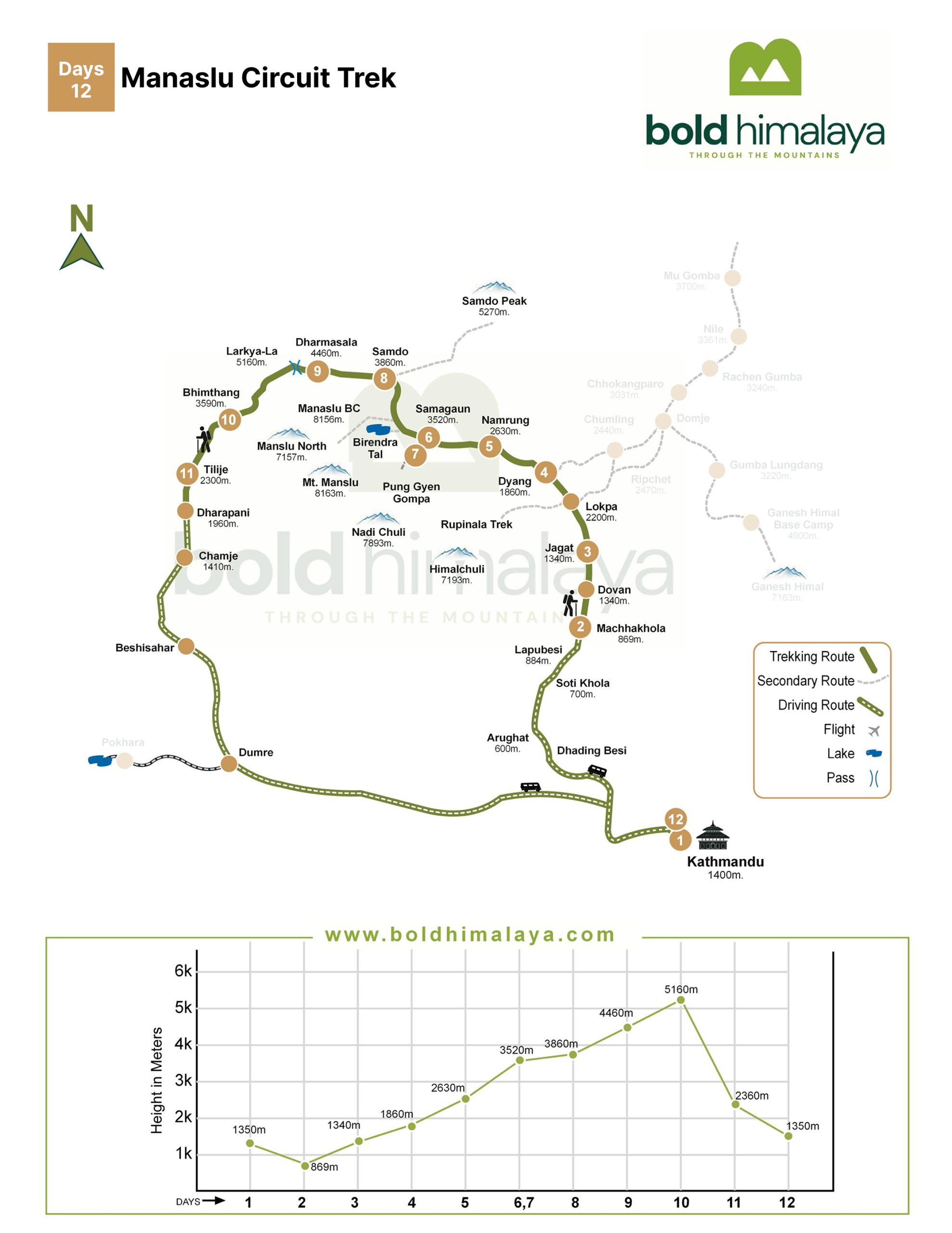
Altitude Chart of Manaslu Circuit Trek
Good to Know
Your Journey, Step by Step
Cost for the Manaslu Circuit Trek
Bold Himalaya provides the Manaslu Circuit Trek, delivering exceptional value. The cost varies based on your group size and desired level of service, such as the hotel in Kathmandu, the number of trekking crew members, and the type of transportation. For our standard service, prices range from USD 750 to USD 1100, primarily determined by group size. Here are the costs for the Manaslu Circuit trek based on group sizes:
Number of Trekkers |
Cost Per Person in USD ($) |
|---|---|
| 1 | 1100 |
| 2-2 | 975 |
| 3-5 | 925 |
| 6-9 | 875 |
| 10-14 | 825 |
| 15-20 | 785 |
Preparation for Manaslu Circuit Trek
The Manaslu Circuit Trek is a challenging adventure that requires both physical and mental readiness, along with the right gear. Here’s how to prepare for a successful and enjoyable trek.
Physical Preparation
Build your stamina and strength well before the trek. Engage in cardiovascular exercises like hiking, jogging, swimming, or cycling to improve endurance. Strength training, especially for your legs and core, is essential to handle the steep ascents and descents. Practice walking long distances while carrying a loaded backpack to get used to the extra weight you’ll carry during the trek. Start training at least 8–12 weeks in advance for the best results.
Mental Preparation
Trekking in the Himalayas can be as much a mental challenge as a physical one. Be ready for long days on the trail, changing weather, and basic accommodations. Use relaxation techniques like deep breathing or meditation to stay calm and focused. A positive mindset will help you enjoy the journey, even during tough sections like crossing Larkya La Pass at 5,160 m (16,930 ft).
Why Manaslu Circuit Trek with Bold Himalaya?
By trekking with Bold Himalaya, you’re choosing experience, safety, and personalized service. Our staff has completed the Manaslu Circuit Trek multiple times, and through this, we are familiar with each section of the trek and can curate the best experience for you.
We offer you the highest value for money, right from experienced trekking staff to cozy accommodation, delicious food, and 24/7 emergency support.
Our trekking team is well-experienced, Nepal Government registered, and insured for all circumstances. With years of experience working in the Himalayas, they are professionals at handling tough trails such as Larkya La Pass and keeping you safe at all times.
What really makes us different is our friendly and hospitable approach. Our guides, as well as our staff members, are not just veterans in the industry, but also very polite and professional, making sure your trek is comfortable and enjoyable.
Most importantly, we tailor your journey exactly as you want it. From the duration of your trekking days to your hotels, transportation, and activities, everything can be tailored to your preference. If you prefer a shorter duration of the trekking adventure or need extra days for activities like excursions to the Tsum Valley, we will offer it.
At Bold Himalaya, you don’t just trek, you create a journey that’s ideal for you.
Ready to embark on the journey of a lifetime? Get in touch with Bold Himalaya today, and let’s begin planning your personalized Manaslu Circuit Trek!
Manaslu Circuit Trek Difficulty
Manaslu Circuit Trek is a challenging trek that exposes you to isolated paths, high-altitude passes, and steep ascents. The highest trekking point is Larkya La Pass at 5,106 m (16,752 ft), and therefore, altitude is the biggest challenge.
High Altitude
You will be at a high altitude and prone to dangers like altitude sickness. Its symptoms are headache, nausea, and dizziness. However, you can overcome this by acclimatizing gradually, spending additional nights at some points, staying hydrated with much water, and avoiding alcohol and smoking.
Cold Temperatures
At high altitude and during winter, the temperature is below freezing, and the risk of hypothermia is higher. Bring warm clothing layers, insulated jackets, gloves, and a good sleeping bag that is rated for be weather.
Trail Conditions
Certain sections of the trail would be slippery, icy, and muddy, especially near the pass, so put on waterproof, tough trekking shoes with proper tread. Have trekking poles handy for assistance.
Physical Stamina
Some days you will have to take long walks that last 6–8 hours, and the trail consists of sharp rises and falls. Engage in cardio activities like hiking, jogging, or cycling weeks before your trek to build physical stamina.
Cultural Etiquette
The Manaslu region is culturally sensitive, so be sensitive to local customs. Dress modestly, ask permission to take a photo, and know a few words of the local language.
Unpredictable Weather
Himalayan weather will probably fluctuate in an instant, from sun to snow, so be prepared with an umbrella or raincoat and layer clothing.
Food Adjustment
You will be eating local cuisine throughout the trek, which will not be like your standard diet, so carry energy bars and snacks as a supplement.
Remote Medical Care
Hospitals are far away, so minor illnesses and injuries must be treated with first aid, so carry a personal first aid kit and basic drugs.
Manaslu Circuit Trek for Solo Trekkers
Solo trekking without a legally registered guide is prohibited within Manaslu since it is a restricted area. If you prefer to trek alone, though, you can join a permit group and hire an individual private guide.
We take care of your permits, group process, and send you a guide who gives you personal attention but respects your desire to trek alone.
Need a solo trek with total safety? Dial +977-9849615880
Available Facilities
Manaslu Circuit Trek facilities are minimal. You will have:
- Accommodation: Basic tea houses with shared dormitories
- Hot Water: Available in lower altitudes, sometimes extra cost
- Internet & Wi-Fi: Available in some tea houses, but slow
- Electricity: Available everywhere except Dharamshala and Samdo. Bring a solar charger or power bank.
- ATMs: Available only in Kathmandu. Bring NPR 15,000–20,000 (USD not accepted on the trail).
Availability of Drinking Water
Drink 3–4 liters of water per day to be fully hydrated. In lower altitude areas, safe water is available, but at higher altitudes, tap or stream water is not safe to drink. Order boiled water at tea houses or take purification tablets and filters.
Electricity and Internet
Electricity is available for charging at most tea houses, typically for a fee. However, Dharamshala and Samdo have limited electricity. The internet connection is slow and unreliable, so don’t rely on it. Take a solar charger or a spare power bank.
ATMs
There are no ATMs along the Manaslu Circuit. Carry enough Nepalese rupees in Kathmandu before undertaking the trek. Carry at least NPR 15,000–20,000 for personal spending. Cards or USD are not acceptable.
Manaslu Circuit Trek Guides
Our guides are extremely familiar with each small detail of the Manaslu district. They ensure safety, provide background and history, and arrange logistics like accommodation and meals.
We also have porters at a small additional cost. We provide porters who can carry up to 20 kg so that you can trek more lightly and experience a better trekking experience, but make sure that your essentials are with you and not in the porter’s bags, as they might not always be walking alongside you.
As a mark of appreciation for their efforts, at the conclusion of your trek, it’s customary to tip 10–15% of the overall cost of your trip.
Documents Required During this Trek
- Passport (with a minimum validity of 6 months)
- Nepal Visa
- Permits (Manaslu Restricted Area Permit, MCAP, ACAP)
- Travel Insurance documents
Nepal Visa Process
Nepal also offers an eVisa facility. You may apply online on the Nepal Immigration portal prior to travel. Otherwise, you can get a visa on arrival at Kathmandu airport. Make sure your passport has 6 months’ validity and carry passport photographs.
For eVisa: https://nepaliport.immigration.gov.np/onlinevisa-mission/application
Necessity of Insurance
Manaslu Circuit Trek should be insured. It must include high-altitude trekking, medical, evacuation, trip cancellation, and personal luggage. This gives security while trekking in remote areas where the weather is unpredictable.
Nepal Cultural Etiquette
- Greet with a Namaste and smile
- Dress conservatively, particularly in villages and temples
- Ask permission to photograph
- Take off your shoes when entering monasteries
- Never point the soles of your feet at people or religious items
- Greet by learning some simple local or Nepali words
- Support the local community and avoid single-use plastics
Exercise Responsible Tourism
- Do Not Waste: Carry refillable items such as water bottles, cutlery, and containers. Take back all your trash and dispose of it there.
- Conserve Resources: Conserve water and electricity in lodges and teahouses; resources are limited in the mountains.
- Avoid Using Plastic: Refill refillable water bottles with safe drinking water or use purification tablets rather than buying bottled water.
- Reduce Carbon Footprint: Use public transport or shared vehicles to travel to trekking starting points.
- Be Respectful towards Wildlife and Nature: Keep a distance from wildlife and do not disturb their habitat. Do not feed wildlife.
- Responsible Purchase: Avoid products manufactured from threatened species or obtained illicitly. Support fair, locally crafted products.
- Culturally Engage: Treat local people with respect, support cultural conservation, and consider making donations to community development projects.
- Follow Rules: Obtain all permits necessary, avoid closed territories, and follow the guidance of your trekking guide.
- Leave No Trace: Take nature with you as you took it, avoid littering, scratching rocks, or disturbing natural formations.
How to Book Reservations for This Trip
You can book the Manaslu Circuit Trek with us directly through our website. Fill up the online form using your own desired trip specifications. You may adjust the plan if needed before sending. We do need a 20% advance payment to hold a booking; this can be refunded in case of cancellation. Once we receive your payment, your spot is confirmed, and we will dispatch all further trip details to you.
For booking or inquiry, contact us at +977 9849615880 using WeChat, Viber, Line, or WhatsApp, available 24/7, or email us at [email protected].
Extendable Trekking Options
After the Manaslu Circuit Trek, you can still experience more of the Annapurna area through various extendable trekking options:
- Tsum Valley Trek: Colourful and remote valley trek
- Annapurna Circuit Trek: Traditional trek with diverse landscapes
- Tsum Valley with Manaslu Circuit Trek: Do them together for an extended trek
- Nar Phu Valley Trek: Off-the-beaten-path trek with stunning high-altitude landscapes
These options allow trekkers to explore more villages, valleys, and Himalayan landscapes after completing the Manaslu Circuit.
Other Options for Trekking
Nepal offers a variety of trekking routes, ranging from easy to challenging, outside of the Annapurna region. Terraced rice fields, open pastures, rocky slopes, and stunning suspension bridges with prayer flags flying are all abundant along the picturesque hiking track. Enjoy the short hikes while taking in the stunning surroundings.
FAQs
Your Questions, Answered
How long is the Manaslu Circuit Trek?
Typically, the trek takes 12 days to travel 177 km (110 miles) from Kathmandu to Besisahar and back to Kathmandu. It can be done within 9 to 16 days based on your own pace, itinerary, and preference.
Is the Manaslu Circuit Trek for beginners?
Yes, fit new trekkers with a walking capacity of 4–6 hours a day can attempt the trek after proper acclimatization and preparation. Larkya La Pass at 5,106m requires good stamina as well as acclimatization.
What else can I trek along with the Manaslu Circuit Trek?
You can join the trek with other treks such as Annapurna Circuit, Manaslu Base Camp, Tsum Valley Trek, or Nar Phu Valley Trek. Bold Himalaya can customize your itinerary based on your duration.
How costly is the Manaslu Circuit Trek?
The price ranges from $950 to $1,400 based on stay duration, services, and group members. Bold Himalaya offers 14 days at $990, including meals, accommodation, and guided service.
What is the best time for the Larkya La Pass Trek?
The best times are spring (March–May) and autumn (September–November) with favorable weather, comfortable temperatures, and wonderful views. Treks in winter (December–February) may have snow, and Monsoon (July) may have heavy rainfall, but it’s still possible.
Do I need supplemental oxygen for the Manaslu Circuit Trek?
No, oxygen is not required. Adequate acclimatization practices, gradual ascent, and adequate hydration are sufficient to avoid altitude sickness.
Is it possible to purchase a Manaslu Trek permit individually?
No, single permits are not allowed. You must trek in a group of at least one person, and the permits are booked through licensed trekking companies.
Solo trekkers allowed?
Solo trek is allowed with a personal guide. For small groups or individual travelers, Bold Himalaya can offer guide services and permits by booking the permit with someone else and later splitting for the solo trek.
What are the advantages of the Manaslu Circuit trek?
The trek provides physical and mental refreshment, breathtaking views of the Annapurna and Manaslu range, glacial lakes, green vegetation and wildlife, and a cultural experience with Gurung and Sherpa villages for a day’s stay.
How many acclimatization days are required for the Manaslu Circuit?
Two acclimatization days in Samagaun and Samdo are enough for the 13–14-day trek.
What is accommodation quality on the trek?
There is accommodation in plain teahouses along the trekking route. Electric facility and hot shower at most locations except very remote destinations like Dharamsala and Samdo. Carry a solar charger for your electronic devices.
How much water do I have to drink while trekking?
Drink a minimum of 3–4 liters of water daily. Drink boiled ot filtered water at high altitudes to avoid dehydration and water-borne diseases.
Are there any ATMs on the Manaslu Circuit?
No, only in big towns. Take 15,000–20,000 NPR for extra expenses since dollars are not accepted.
What gear and clothing should I bring?
Layering attire, down jackets, hats, gloves, trekking boots, trekking poles, and sub-freezing sleeping bags are essential items. Thermal set-up is optimal in winter, but comfortable light clothes are sufficient up to Namrung during the daytime.
What physical conditioning level do I recommend?
Cardio training, pack hiking, and leg and core training will prepare you for the more strenuous hiking days and mountain ascents.
What is the mental preparation needed?
Patience, concentration, and positive mental attitude are needed. Stress training, meditation, and proper breathing will allow you to hike at high altitude without danger.
What are the cultural etiquette in the local area?
Be courteous to local culture, dress modestly, say “Namaste” while meeting locals, request permission to take photographs, and adhere to monasteries’ rules.
What are trekking safety measures?
Your safety is attended to by porters and guides, who monitor altitude sickness, assist with logistics, and provide cultural sensitivity. At least first aid kits are recommended.
How do I reserve the Manaslu Circuit Trek?
Book online via Bold Himalaya’s online booking form with a prepayment of 20%. Contact Nepal Mobile +977 9849615880 on WhatsApp, Viber, Line, or WeChat for inquiry or customization.
Reviews
What Our Travelers Say
Also Check OutOther Similar Packages
Each trek is unique in its own way and each adventure will inspire you differently. Discover other popular tours that are visited by thousands of travellers annually.

Save 29%
Annapurna Circuit Trek
One of the most famous trekking routes in the world is...
2 Day Kathmandu Valley Sightseeing Tour
Kathmandu Valley Sightseeing Tour: The capital and most popular travel destination...






